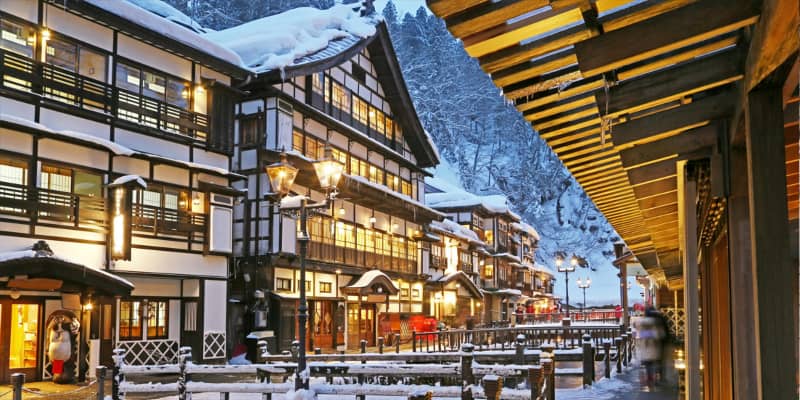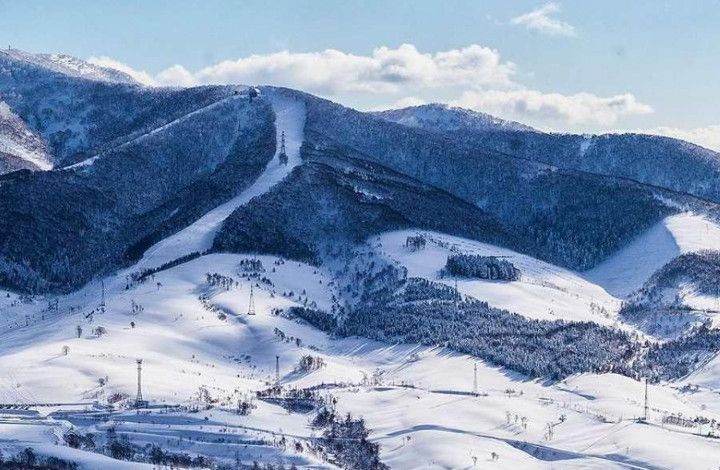When many travelers think of Japan, they envision swaying cherry blossoms or stunning autumn foliage. However, Japan also boasts a substantial snow season, complete with all the winter sports such as skiing, snowboarding, ice sculpting, at one of more than 500 resorts.
Read on to learn about the unique winter adventures this country has to offer.
When is the snow season in Japan?
Japan’s snow season typically begins in mid- to-late December, just before Christmas, and continues through late March or early April. This will vary from resort to resort based on the actual snow conditions. The season peaks from mid-January to late February.
Some winter resorts open in late October. Often, such resorts employ snow-making machines to give “mother nature” a boost. The earliest-opening resort is newsworthy, and in many years is Snow Town Yeti in Shizuoka, at the foothills of the iconic Mt. Fuji.
If you hope to beat the crowds, a December trip will afford fewer competitors on the slopes. However, December snows are a gamble in areas not assisted by snow-making machines.
Northernmost areas, such as those in Hokkaido and Tohoku, are more likely to experience early snowfall. On-piste ski slopes are more likely to have adequate snow cover than off-piste slopes.

Instead, you may avoid crowded lifts by planning your visit during the week, avoiding weekends and holidays.
In the country’s northernmost reaches or at high altitudes, winter resorts may continue operating through the “spring skiing season” until late May. Mt. Gassan in Yamagata Prefecture remains open until late July; because of heavy winter snowfall, Mt. Gassan is inaccessible during the winter months and begins its skiing season in April. Some resorts close for a few months during the depths of winter because of excessive snow.
April is a good time for beginner skiers to visit, as much of the crowds have dissipated. You’ll also find good deals on accommodations and lift tickets at this time.
Snow in Japan
Japan is lauded for the consistency and sheer volume of snowfall it receives. The powder conditions are often ideal for winter sports, as is the varied terrain offered by hundreds of resorts. In fact, Japan is considered one of the best locations in the world for skiing and snowboarding,
What makes for these ideal conditions? Japan is fortuitously situated so that it receives cold air masses from Siberia, which pick up moisture as they cross the Sea of Japan. As this moist air climbs Japan’s mountains, heavy snowfall occurs – with some areas receiving an average of three to six meters (10 to 20 feet).
Because winter temperatures remain low, the powder often stays light and fluffy all day long. Even as the season winds to an end, most skiers can find a trail or two with sufficient coverage for a good run.
Where to enjoy the snow in Japan
Some of the best towns to enjoy the snow in Japan include:
- Ginzan Onsen, Yamagata – A hot spring town along the Ginzan River which conjures a magical mood in winter with its ryokan traditional wooden inns and gas lamp-lit streets.

- Nikko, Tochigi Prefecture – Boasts a number of UNESCO World Heritage sites, including the famous Nikko Toshogu Shrine, as well as a number of onsen hot springs with supposed healing properties.

- Nyuto Onsen, Akita – Located in Towada-Hachimantai National Park, Nyuto Onsen offers a collection of natural hot springs and ancient wooden inns on the shores of the deepest lake in Japan.

- Otaru, Hokkaido – This northern city, with its canal, brick buildings, and Victorian-style streetlights, has a distinctly European vibe, especially when covered by snow in the winter.

- Ouchi Juku, Fukushima – A historic post town which has been restored to its original condition, full of ryokan inns where you can try the local delicacy: fish grilled on a sunken hearth.

- Shirakawa-go, Gifu – A UNESCO World Heritage Site filled with historic thatched-roof farm houses, many of which now serve as tourist accommodation.

In addition to these snow-laden towns, there are also a huge number of world-class ski resorts in Japan where visitors can enjoy a wide range of winter sports.
Ski and winter sports resorts
Some of the best skiing and snowboarding resorts in Japan are concentrated in two areas: the island of Hokkaido and in Hakuba Valley in the Japanese Alps near Nagano, although there are several other exceptional resorts scattered throughout the country.

Some of the most popular resorts in Japan include:
- Furano – Offers several impressive powder snow runs and an authentic Japanese resort village
- Happo One Resort – Situated in Hakuba Valley, the site of the 1998 Winter Olympics
- Niseko – Boasts a resort village with world-renowned nightlife and after-dark skiing
- Nozawa Onsen – Stays open late into the season and offers a number of onsen hot springs
- Rusutsu – Boasts some of Japan’s heaviest snowfalls and some of the best powder snow in the world
- Shiga Kogen – One of the largest ski resorts in Japan, offering terrain for all levels of skiers, from beginners to advanced powderhounds.
Snow festivals
Japan’s snow season has also given rise to a number of snow festivals.
The Sapporo Snow Festival is one of the most popular, featuring enormous, detailed snow and ice sculptures.

In February, the Otaru Snow Light Path bathes the city of Otaru in romantic winter illuminations and small sculptures.
Others include the Asahikawa Winter Festival, Tokamachi Snow Festival, and Yokote Kamakura Festival.

Winter Japanese wonders
You can also experience unique natural wonders in Japan during the winter. While the snow monkeys at Jigokudani Monkey Park can be seen bathing in the hot springs year-round, this behavior is most pronounced in winter.

Another perk of enjoying the snow in Japan is the prevalence of onsen or natural hot springs. Nothing is more refreshing after a day on the slopes than a rejuvenating soak!
The experience is enhanced by the snowscapes visible from many onsens. Bars and restaurants are typically located on resort grounds or in nearby towns, allowing you an authentic taste of Japanese cuisine.
Zao Onsen is famous for its “snow monsters” – heavy snow covering the trees that are frozen into monstrous shapes by the wind. Drift ice, called ryuhyo, can be seen off Hokkaido’s coast.

So, pack your best thermal wear, reserve your JR Pass, and start planning to hit Japan’s slopes!
